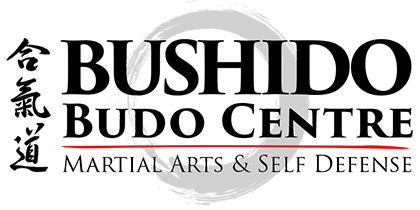Etiquette
Proper etiquette is a fundamental aspect of Aikido practice. While new students will quickly learn the etiquette of the dojo by attending class regularly, a basic overview is written below. The etiquette of Aikido should not be limiting or humiliating, but rather should feel natural and good-natured.
Please make an effort to arrive at least ten minutes before class begins. Give yourself ample time to change into your gi or work-out clothes and to prepare your mind for training.
While in the dojo, please do not wear outdoor shoes. Shoe racks are provided at the entrance for your convenience. You are welcome to bring indoor sandals or slippers.
While sitting on the mats, please sit in seiza (traditional Japanese sitting posture), or if uncomfortable, with crossed legs. Do not lean against the walls or sit with your feet splayed out. As well, please do not sit or stand with your back to the shrine at the head of the dojo.
Cleanliness
Please ensure that your gi and body is clean before class. Keep your nails cut short. Do not wear earrings or other jewelry on the mat. Do not chew gum while training.
Bowing
Bowing is a practice of humbleness, respect, and gratitude towards your fellow Aikido practitioners, and the martial artists who have paved the way for our practice. It is the most tangible and often-seen facet of Japanese etiquette seen during Aikido practice. Bowing is in Japan as shaking hands is in the west; there is no religious connotation in our dojo.
Standing bow: With your arms by your sides, bow from your hips while keeping your back straight. Incline your upper body about forty-five degrees.
Seated bow: While in seiza, place your palms close together on floor in front of you and incline your upper body until it is at least parallel to the ground. Try to keep your back straight.
When entering or leaving the dojo, it is polite to do a standing bow towards the shrine at the head of the mat area. Anytime when stepping onto or off the mats, a standing bow towards the shrine should be performed on the edge of the mat. Face the shrine when stepping off of the mats.
If bowing to a person higher in rank than yourself, bow first, and allow them to raise their head before you do.
During Class
At the beginning and end of class, students sit in a line and the instructor leads the formal bow to the shrine. This consists of two bows, two claps, and then another bow. The instructor then turns to the students and both parties bow to one another and say onegaishimasu (at the beginning of class) or doumo arigato gozaimashita (at the end of class). Please allow the instructor to raise their head before you do during the bow-in.
During class sessions, please address the instructor as “Sensei”.
Please keep talking to a minimum while practicing. Any discussions on the mat during class should be related to the training.
If you need to take a water or washroom break, try to do so while the instructor is not actively teaching, and ensure you bow to the shrine when leaving and re-entering the mat.
When receiving instruction from Sensei, it is polite to sit down rather than stand. After the instructor is finished demonstrating, bow to them and say onegaishimasu. While sitting or standing, do not have your back to the shrine.
When beginning to practice with a training partner, it is polite to bow and say onegaishimasu (“please do this for me”). When you are finished training with your partner, bow and say arigato gozaimashita (“thank you very much”).
If you must leave class early, please inform the instructor ahead of time – preferably before the class begins. When leaving, notify the instructor and then do a seated bow to the shrine at the edge of the mat.
Lateness
In the event that you are late, please sit on the edge of the mat, formally bow to the shrine (two bows, two claps, and one bow) and then wait for the instructor to acknowledge you. Bow to the instructor and say onegaishimasu, and then join the class.
